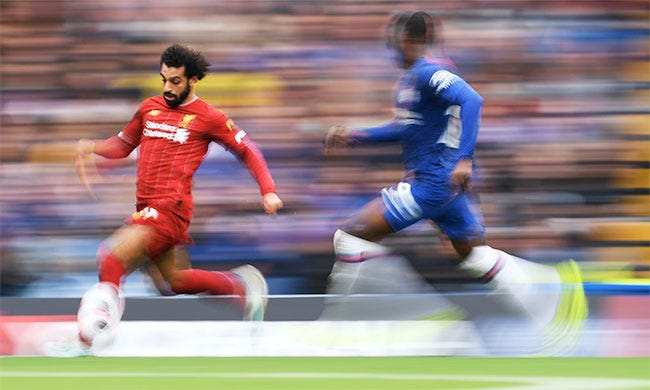

Discover more from Free Kick! from We Are Soccer
How far do soccer players run in a game?
And how far do pro athletes in other sports run? We break it all down.
I’m often asked how far professional soccer players run in a game. There’s no simple answer, but we can break it down and give you an idea of how far players run, depending on what position they play.
Last week we wrote about the “sports bras” that players wear. If you missed the article, go ahead and give it a read here. Essentially, the sports bra that players wear is to hold the pod/tracking device that they wear in games. These devices track the player’s heart rate, body temperature, top speed, where on the field they spent the most time (heat map), and the obvious one, distance covered. Because of these devices, we can accurately track how far players run in a game.
Now, you might think that the goalie probably runs close to zero miles. But, at the top level, a goalie is constantly moving. When the ball is at the opposite end of the field, a goalie needs to move up the field and will move from side to side depending on where the ball is. A goalie should ALWAYS be between the middle of the goal and the ball. If you ever watch a goalie in action, you’ll notice the amount of backpedaling they do, and constant side-to-side movements, especially when the ball is in and around their 18-yard box. All those movements add up, and a goalie will move on average, about 2 miles per game over the course of 90 minutes. I bet you didn’t see that number coming!
In the 2018 World Cup match between Mexico and Germany, Mexican goalkeeper Guillermo Ochoa was tracked to have covered 2.4 miles.
Before we go any further, why don’t we put some perspective behind these numbers and show you how far professionals in some of the other top sports run!?
Football: Wide receivers and cornerbacks have been tracked to run approximately 1.25 miles per game.
Baseball: The bases are 90-feet from each other, so there isn’t much distance covered for baseball players in a game. We can safely assume that players run less than 1 mile per game. To be honest, the fans walking into the game probably cover more ground than the actual players do during the game.
Tennis: With all the back-and-forth, over the course of a 5-set match, players can cover between 3-5 miles.
Basketball: You’d think with all the up the court, down the court, jumping and running within basketball, that the distance covered would be greater than the average of 2 miles that they are tracked. But it’s not. Back in 2012, according to STATS, the player who ran the farthest per game was Luol Deng of the Chicago Bulls, at 2.72 miles on average.
So you can see that soccer players run much further than any other professional sports. We’ve seen goalies can cover close to 2 miles per game, but what about the rest of the positions?
The position of being a defender has changed greatly over the past two decades. In the olden days, defenders were solely charged with stopping the opposing team’s attackers from scoring, and they would rarely venture into the offensive end of the field. But now, a defender does so much more. They are responsible for getting up the field and initiating the attacks if not being in the attack at the end itself. Wing backs have to get up and down the sidelines to help cross balls in, and then track back once the ball is turned over. This running all adds up. In the 2016-17 Premier League season, Chelsea’s full-back Marcos Alonso was estimated to have run 7.2 miles per game. As a defender, that’s an incredible distance to cover in 90-minutes.
Midfielders control the game and dictate the scheme that the manager and team are trying to employ for that game. Also, midfielders are responsible for disrupting the opposing team’s game-plan. All while running from 18-yard box to 18-yard box. And, if you happen to be a wide midfielder, you’d better be in good shape, because you can expect to run close to 9 miles in the game. Typically, no matter where you play in the midfield, somewhere between 7.5-9 miles is the distance that you’ll end up covering. That’s a lot of running!
So, that leaves our goal-scoring heroes. How much ground do forwards cover? During the 2018 World Cup in Russia, Belgium striker Romulu Lukaku covered approximately 6.3 miles per game. He may not run as much as his midfielders, but as a forward, he’s not far behind them.
Ever wondered what the highest recorded speeds were by soccer players? We got you!
Gareth Bale (Real Madrid): 22.92 mph
Orlando Berrio (Flamengo): 22.3 mph
Kylian Mbappe (PSG): 22.3 mph
Inaki Williams (Athletic Bilbao): 22.1 mph
Theo Walcott (Everton): 22.1 mph
Today’s FREE KICK! Newsletter is brought to you by the Just Play App.
Interested in playing soccer, but have a busy schedule and need the flexibility to pick & choose when & where? The Just Play App is solving this problem many of us have by making Pickup Soccer readily available for even the busiest of people! Download the app, find a game that fits your schedule, RSVP, and show up...we take care of the rest! Awesome community of over 2,000 users playing 14+ games / week across Metro Detroit and growing quickly!
Interested in sponsoring FREE KICK! contact us at craig@wearesoccer.show
Subscribe to Free Kick! from We Are Soccer
We are the premier soccer show, podcast, and newsletter for soccer fans of all ages.










